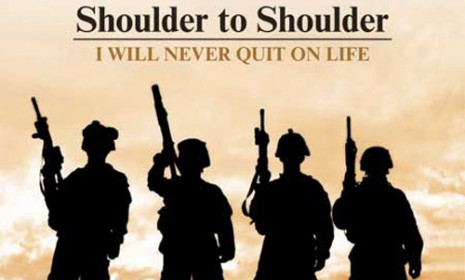Could a nose spray lower the Army's suicide rate?
More soldiers have committed suicide this year than the number who have died in combat, so the Pentagon is investing $3 million into a quick-acting solution

The Army has a huge suicide problem. In July, the number of soldiers who killed themselves (38) amounted to more than double the number from the previous month; that was also the highest one-month tally since the military began keeping suicide records. That brings this year's total suicides for active-duty soldiers to 116 so far, and doesn't even account for veterans with post-traumatic stress disorder or depression. To address the rampant problem, the Pentagon is investing $3 million for doctors at the University of Indiana to develop a new solution: A nasal spray that, hopefully, will keep depressed soldiers from making irrational decisions. Here's what you should know about the project:
How bad is the suicide problem?
It's "the toughest enemy I have faced in my 37 years in the Army," Gen. Lloyd J. Austin III, the Army's vice chief of staff, tells The Daily. This year, for example, suicides average one per day, surpassing even combat fatalities. "That said, I do believe suicide is preventable," says Austin. "To combat it effectively will require sophisticated solutions aimed at helping individuals to build resiliency and strengthen their life coping skills."
The Week
Escape your echo chamber. Get the facts behind the news, plus analysis from multiple perspectives.

Sign up for The Week's Free Newsletters
From our morning news briefing to a weekly Good News Newsletter, get the best of The Week delivered directly to your inbox.
From our morning news briefing to a weekly Good News Newsletter, get the best of The Week delivered directly to your inbox.
What does the nose spray do exactly?
The active ingredient is a thyrotropin-releasing hormone (TRH), and it has "already shown promise," says Eric Limer at Gizmodo. In clinical trials, TRH has been shown to help alleviate suicidal urges, depression, and bipolar disorder. The big problem with it, however, is that it can only be administered via a spinal tap. "Nobody wants a spinal tap, especially people who are depressed and suicidal," says Limer. "We've known since the 1970s that TRH has antidepressant effects," says project leader Dr. Michael Kubek. "The bottom-line problem has been figuring out how to get it into the brain."
Why a nasal spray?
The main problem with TRH is that it can't cross the blood-brain barrier in pill or shot form. But recent breakthroughs in something called "nanoparticle delivery systems" make the nose a viable entry point for introducing drugs to the brain, says Limer. A spray would, in theory, be able to penetrate the blood-brain barrier, working "rapidly" to create a "euphoric and calming effect," says Dvice. "This is a brilliant idea," Dr. Ken Duckworth, medical director of the National Alliance on Mental Illness, tells The Daily. "It would solve one of the biggest problems we have with medication used today."
A free daily email with the biggest news stories of the day – and the best features from TheWeek.com
How would soldiers use it?
It wouldn't entirely replace traditional anti-depressants. Instead, researchers envision it as preventative in moments of crisis, or after a patient starts taking medications like Prozac or Zoloft, which often take weeks to start working. "As a public health concern, suicide is something we haven't had success in addressing," says Duckworth. "There is a crying need out there for something like this."
-
 Political cartoons for December 6
Political cartoons for December 6Cartoons Saturday’s political cartoons include a pardon for Hernandez, word of the year, and more
-
 Pakistan: Trump’s ‘favourite field marshal’ takes charge
Pakistan: Trump’s ‘favourite field marshal’ takes chargeIn the Spotlight Asim Munir’s control over all three branches of Pakistan’s military gives him ‘sweeping powers’ – and almost unlimited freedom to use them
-
 Codeword: December 6, 2025
Codeword: December 6, 2025The daily codeword puzzle from The Week